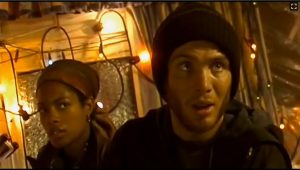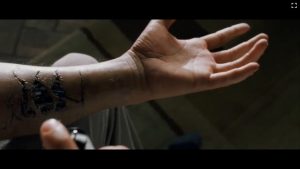Sequence 1: The movie opens with random scenes of chaos (riots, fighting, screaming) with an overlay of broken newscasting audio.
Sequence 2: Militant environmentalists liberate chimpanzees that have been held in a lab, believing that the scientists have been harmfully testing on them. A scientist attempts to stop them but is restrained.
Sequence 3: A chimp attacks one of the environmentalists, pukes blood, and spreads the infection that the scientist has dubbed ‘Rage.’
Sequence 4: A man wakes up naked and alone in a seemingly empty world. He walks around the city and there is only trash, missing person photos, and silence. White text reads 28 days later
Sequence 5: The man finds a church full of dead bodies. He is chased by senseless humans with dilated red eyes that seem to want to harm him.
Sequence 6: The man, Jim, is saved by 2 uninfected humans, Serena and Mark, that take him an abandoned store to hide out. They explain to Jim (and to us) what has happened in the last 28 days and that they are essentially occupying the post-apocalypse
Sequence 7: They stay the night at Jim’s family home and Jim’s nostalgic viewing of old family videos compromises their hideout. Mark becomes infected in the ensuing battle and Serena kills him immediately.
Sequence 8: Jim and Serena find an uninfected father and daughter, Frank and Hannah, and stay with them in their apartment. Frank reveals that they are running out of resources and, now that Jim and Serena have arrived, he would like to travel to a military blockade claiming to have a cure for Rage.
Sequence 9: The four travel together to the blockade. Their tire bursts and they narrowly escape a horde of humans infected with Rage.
Sequence 10: They stock up on food and gas during their trip. At the gas station, Jim must kill a young infected boy and is saddened by it.
Sequence 11: They take a break from driving on the countryside. Serena kisses Jim on the cheek.
Sequence 12: They arrive at the site of the military blockade and find only ruins. The father heckles a crow for picking at a dead body. He bangs the gate to make the crow leave but blood falls from the body into his eye. He is infected with Rage but then is killed by the soldiers that were looking for.
Sequence 13: The head of the site, Major Henry West, takes Jim on a tour. Jim sees that they have chained up an infected former officer for study.
Sequence 14: Infected humans attack the military blockade during the first dinner and the soldiers kill the threat. Jim and Serena watch from indoors.
Sequence 15: After, the other officers make sexual advances toward Serena. Jim intervenes on her behalf.
Sequence 16: Major Henry West reveals that he has promised both Serena and Hannah to the officers for both pleasure and procreation. They try to escape and are apprehended.
Sequence 17: Jim narrowly escapes death when they plan to shoot him in the forest. He returns to the mansion as it begins to rain.
Sequence 18: The officers circle Serena and Hannah and demand they change into dresses in front of them. Serena kisses an officer and asks that they leave. Her plan to commit suicide using pills is halted when an officer bursts back in and stops them.
Sequence 19: Jim begins to pick off the officers one by one. He releases the captive infected soldier from his chain and the infected soldier kills many of the officers in the building.
Sequence 20: Now in dresses, Serena and Hannah attempt to escape but are again apprehended and forced to stay as the remaining action unravels.
Sequence 21: Serena almost kills Jim as they reunite (believing that he has been infected) but she hesitates and sees that he is clear-eyed.
Sequence 22: Serena and Jim and Hannah escape.
Sequence 23: Serena, Jim, and white girl reside in peaceful solitude. The movie ends on a hopeful note; they flag down a plane and receive help.

28 Days Later is a gory post-apocalyptic vision of humanity, featuring a white protagonist and an unlikely combination of characters that work with him toward mutual success. Through a painfully long series of events, we witness our protagonist, Jim, navigate the fine line between survival and brutality. Along the way, Black characters essentially appear to fulfill the cinematically flat roles of ‘romantic interest’ or ‘unforeseen evil.’ The film treads the line of the racial and post-racial ultimately revealing an unavoidably racialized undertone relayed both through video and audio.
This frame is a medium close-up of Jim and Serena’s faces. The light hits most of Jim’s face. Serena’s face is visible but not illuminated, though faery lights flare up behind Serena’s head. The camera is eye-level with Jim. Neither Jim nor Serena is dead-center in the frame, but Jim is in the foreground and clearly the focus. Serena and Jim seem close to the audience. Their eyes are both cast to their left and upward. Due to a combination of lighting and coloring, Jim’s face is starkly contrasted with this costume whereas Serena’s face blends and/or is similar to the color palette of her costume. Serena’s expression and positioning make her appear smaller than Jim.
I chose this frame because it best points to the transition of Serena from the badass survivalist we all meet at the beginning of 28 Days Later to the demure damsel-in-distress the film leaves us with. In this frame, we literally see that Serena’s body is obscured both by the lens and by Jim himself. Moreover, this action seems both willful on the part of the director and on the part of the character, Serena. The effect of this in the larger scheme of the film is that Jim appears to have a ‘humanizing’ effect on Serena. Simply, before Serena meets Jim, she is entirely geared for survival, literally murdering someone just at the prospect that they might infringe on her safety. Through her encounters with Jim, Serena loses her cutthroat personality and willfully conforms to a stereotype of white womanhood before our eyes.
Essentially, this seems to suggest that the survival of Black woman rests on conformity. Serena is most valuable when is merely a sexualized body. Though the racialized tone of this sexualization is evident, it is clear that Serena becomes more human when she exists or conforms to the rigid statutes of white patriarchy. As C. Riley Snorton writes in “Gender,” “gender provides an aperture into modes of survival and personal or collective experiences of vitality” (Snorton 91). The future of human polity rests on her body and sexual reproduction; Serena’s survival, therefore, is predicated on her ability to service the future of humanity. Her Blackness is rendered as both hypervisible and invisible by this future-oriented role. As Snorton describes, Serena’s gendering is directly tied to the at-risk condition of her life, presently and historically.


